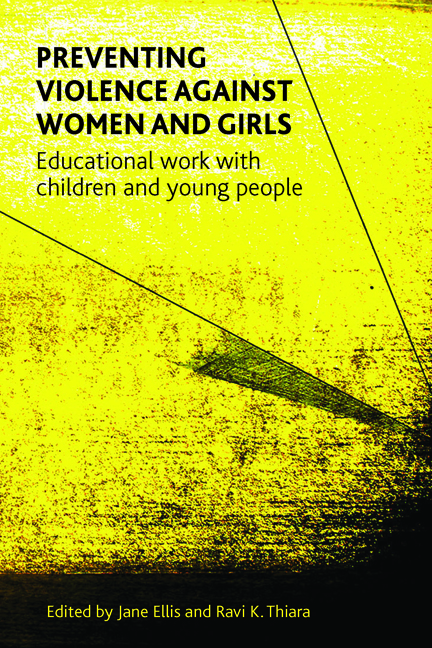Book contents
- Frontmatter
- Dedication
- Contents
- List of tables and figures
- Notes on contributors
- Acknowledgements
- Foreword
- Introduction
- one Preventing violence against women and girls through education: dilemmas and challenges
- two Does gender matter in violence prevention programmes?
- three Responding to sexual violence in girls’ intimate relationships: the role of schools
- four ‘Pandora’s Box’: preventing violence against black and minority ethnic women and girls
- five Preventing violence against women and girls: a whole school approach
- six What did you learn at school today? Education for prevention
- seven No silent witnesses: strategies in schools to empower and support disclosure
- eight Preventing sexual violence: the role of the voluntary sector
- nine ‘Boys think girls are toys’: sexual exploitation and young people
- ten MsUnderstood: the benefits of engaging young women in antiviolence work
- eleven Shifting Boundaries: lessons on relationships for students in middle school
- Concluding remarks
- Appendix: Examples of programmes in the UK
- Index
one - Preventing violence against women and girls through education: dilemmas and challenges
Published online by Cambridge University Press: 04 March 2022
- Frontmatter
- Dedication
- Contents
- List of tables and figures
- Notes on contributors
- Acknowledgements
- Foreword
- Introduction
- one Preventing violence against women and girls through education: dilemmas and challenges
- two Does gender matter in violence prevention programmes?
- three Responding to sexual violence in girls’ intimate relationships: the role of schools
- four ‘Pandora’s Box’: preventing violence against black and minority ethnic women and girls
- five Preventing violence against women and girls: a whole school approach
- six What did you learn at school today? Education for prevention
- seven No silent witnesses: strategies in schools to empower and support disclosure
- eight Preventing sexual violence: the role of the voluntary sector
- nine ‘Boys think girls are toys’: sexual exploitation and young people
- ten MsUnderstood: the benefits of engaging young women in antiviolence work
- eleven Shifting Boundaries: lessons on relationships for students in middle school
- Concluding remarks
- Appendix: Examples of programmes in the UK
- Index
Summary
Introduction
The prevention of VAWG through education brings with it the imperative to consider its theoretical foundations since it is suggested that effective programmes make explicit two types of theories: one related to the cause of VAWG and a second addressing the means by which change might be brought about, a theory of change (De Grace and Clarke, 2012). Evidence from research in the UK (Ellis, 2004a) and elsewhere (Mulroney, 2003) shows that many programmes lack theoretical clarity in both respects. While this poses difficulties in the design, delivery and evaluation of initiatives, there is also often little consideration of prevention itself; equally problematic, however, is a lack of critical theorising about children and childhood. This chapter considers contemporary ideas of prevention and the implications this has for feminist challenges to VAWG through work with children and young people, principally in schools. Offering prevention as a solution is significant for children, in how VAWG is understood and how efforts to end VAWG are mediated in educational discourse. Beginning with a discussion of prevention and its use in contemporary policy, with a brief outline of the two dominant conceptual models, public health and prevention science, consideration is then given to some of the dilemmas and challenges these present. The chapter concludes with some thoughts on reframing the prevention of VAWG through education within a framework of children's rights and feminist poststructuralism. In engaging in a critique of prevention, it is not my intention to undermine the project of attempting to end VAWG but more to illuminate the context in which it has developed in order to inform reflective and reflexive policy and practice so that adults might better engage with children in this endeavour.
Prevention in social policy
Prevention is widely deployed as a key strategy for addressing a range of social issues. This is nowhere more evident than in policies concerning children and young people (Chief Secretary to the Treasury (CST), 2003; Sutton et al, 2004; HM Government, 2008; Department for Children Schools and Families (DCSF), 2010; Allen, 2011). Whilst there is an ever-increasing amount of research, policy and practice on prevention, there is a commonsense view that we know what it is. It is, however, a ‘“slippery” concept’ (Billis, 1981: 368). The idea of prevention has been enthusiastically taken up by both the current and last governments in England.
- Type
- Chapter
- Information
- Preventing Violence against Women and GirlsEducational Work with Children and Young People, pp. 21 - 44Publisher: Bristol University PressPrint publication year: 2014



